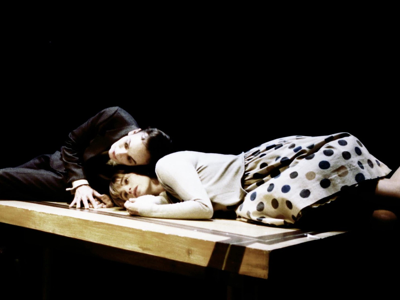To help you see the richness that a story can offer, I summarise below an analysis by J.L.Styan, from his book, “The Dramatic Experience”. Styan lists six levels to narrative, and uses the example of King Lear, to illustrate.
The level of plot and narrative. At its “simplest”, King Lear is a story of a domestic quarrel which has implications for the family and state. The interest for the audience is, “What will happen?”
The level of the pschyological. The interest here is our speculation as to basic personality, motive (“Why did s/he behave like that”). We watch as several characters, not least Lear, grow in their understanding of themselves through the course of the play.
The level of morality. This level recognises that good and bad exist as realities, even though the sophistication of the play doesn’t reduce characters to simple ‘goodies’ and ‘baddies’. For the audience, the play becomes an allegory about confronting such realities.
The level of the philosophical. For Styan, this level of the play is a debate on God and the problem of suffering. Watching the play, we are constantly being stimulated by Shakespeare as he studs each incident with meanings much bigger than could be contained by mere plot.
The level of the poetic. Styan considers this level to be a dirge or lament on humankind’s ambiguous position, somewhere between angel and animal, which is communicated by the play’s powerful images, linguistic rhythms and musicality.
The level of the ‘dramatic pattern’, where the audience responds on the aesthetic level to the play’s coherent tying of meaning to a tight dramatic structure.
To Styan’s list, I would add the following:
The level of the sensual. Humans live as sensual beings, however dulled they may sometimes be. In Lear, the role of the senses is strong. There is much for the ear, the eye and every other sense to relish, not to mention the visceral revulsion in Gloucester’s eyes being gouged out.
The level of the social and political. A play is often a statement about the intentioned organisation of society, whether political or not. In KingLear, the role and power of politics and the dominant group is obvious.
The level of the physical. A play will often deal with the impact of living on our physical selves. Comedy is frequently a celebration of the collision of bodies and matter. People fall over, don’t fit into doors. Their lives, energies and imaginations are constantly at war with the material world, and it shows on their damaged bodies.
The level of the metaphysical. A play is ultimately about “what implications this story has for our own inner lives.” Styan partly deals with this in his poetic and philosophical levels, but there is a point at which a description of this function as “philosophy” is not adequate. This is the level at which a play becomes a mandala, some indefineable thing beyond words, but which allows us to brood on multiple meanings and implications for us, as human beings. The chief beneficiary of this level is not our consciousness but our other “selves”– our intuition, our instinct, our dreaming self.
Having discussed these various levels of a rich play, how do we go about ensuring that our own plays have these levels? The first step is to know that the levels exist. The second is for us as writers to apply these levels to each major character (and each major relationship), asking very specific questions of that character. The effect of these questions is to ‘mesh’ levels together (as indicated in the following brackets). Here are several questions you could apply to almost any major character:
– What physical live does he lead? (This question explores the relation between the social and the physical)
– What is the effect on his body of the life he leads? (The relation between the moral and the physical selves of a character.)
– What does he dream of at nights? (The social/conscious meeting the intuitive/unconscious.)
– What does he do for a living—and to what extent is this a sign of his success/failure in the economic and social world? (This question explores the idea of ‘the job as symbol of the character’s social position’, involving consideration of a range of levels—economic, monetary/financial, social etc.)
– What is his Achilles heel? (Is he, emotionally-speaking, a child? Does he lack compassion? (This weakness or ‘lack’ would have clear consequences in the character’s public or private life.)
– How does he see human life? As a game? A mad farce? A pointless routine? A joyful romp without consequences? (Whatever way that this character sees life would have clear implications for how he treats himself and all those around him.)
Many more questions could be asked of the major characters in your play. Chapter 16 provides you with the opportunity to ask, literally, hundreds of such questions.
